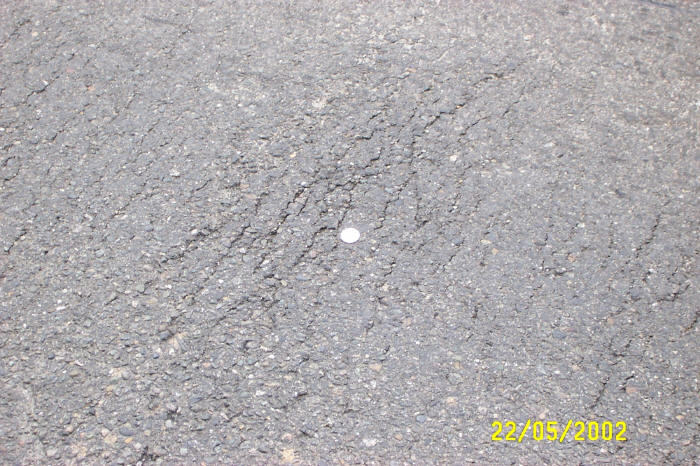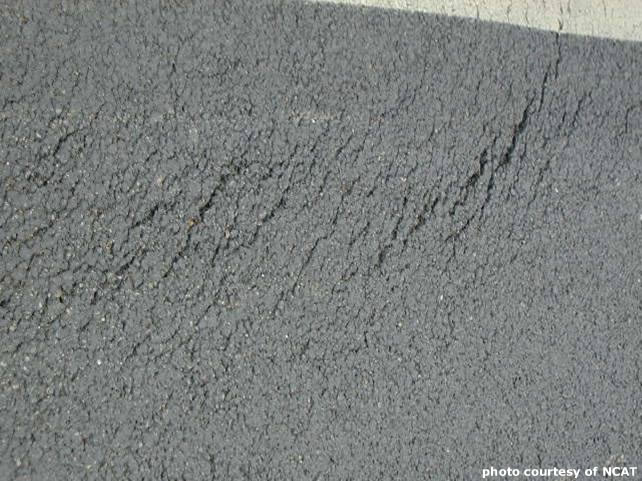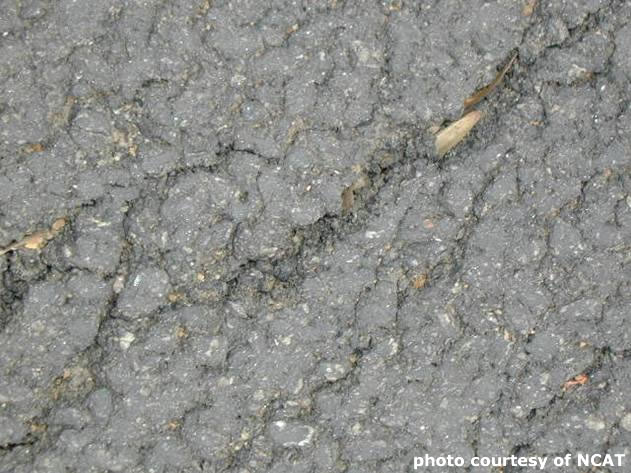Description
Short transverse cracks usually 25 – 75 mm (1 – 3 inches) long and 25 – 75 mm (1 – 3 inches) apart that appear on the mat surface during compaction.
Problem
By itself, microcracking is only a small detriment to pavement performance; the cracks are usually quite shallow and small. However, microcracking can indicate mix tenderness, which can eventually lead to inadequate compaction either because (1) the mixture shoves rather than compacts under roller loads or (2) in an effort to avoid checking rollers are left off the mat so long that they are not able to complete compaction before cessation temperature is reached. Therefore, microcracking can be an indirect indication of inadequate compaction. Inadequately compacted areas have higher air voids and are susceptible to decreased stiffness, reduced fatigue life, accelerated aging/decreased durability, rutting, raveling, and moisture damage (Hughes, 1984[1]; Hughes, 1989[2]). Microcracking can also be an indication of compaction of a cool mat. If a mat is too cool, the applied compactive effort may cause the surface to fracture.
Possible Causes
There are two principal causes of microcracking:
- Roller checking. Mat deflection during compaction that is great enough to fracture the mat surface. It can be caused by two principal means:
- Excessive pavement deflection during compaction. If underlying layers of HMA, base or the subgrade deflect excessively under roller loads, the mat will also deflect placing portions of the mat surface in tension. If this tension is enough to overcome HMA cohesive forces, tiny fissures or cracks will develop on the surface.
- Mix tenderness. Tender mixes tend to shove when compacted, which causes areas of localized tension in the mat surface. If this tension is enough to overcome HMA cohesive forces, tiny fissures or cracks will develop on the surface.
- Compacting an excessively cool mat. If rollers are operated on a cool mat, the surface can be cool enough and therefore stiff enough to fracture under the compactive effort.
Solutions
Solutions differ depending upon the cause:
- Excessive pavement deflection during compaction. Properly prepare the surface on which the new mat is to be placed.
- Mix tenderness. Eliminate the causes for tender mixes or develop a compaction sequence and pattern to accommodate the tender mix. Compaction sequence and patterns will depend upon the type of mix tenderness.
- Compacting an excessively cool mat. Do not continue to compact a cool mat that shows signs of cracking under roller loads. In extreme cases, if the mat below the surface continues to compact and the compaction must be done to achieve adequate mat density, then the trade off between microcracks (if compaction is continued) and a low-density mat (if compaction is stopped) must be carefully weighed.
- Hughes, C.S. (October 1984). “Importance of Asphalt Compaction.” Better Roads, Vol. 54, No. 10. pp. 22-24.↵
- Hughes, C.S. (1989). National Cooperative Highway Research Program Synthesis of Highway Practice 152: Compaction of Asphalt Pavement. Transportation Research Board, National Research Council. Washington, D.C.↵



